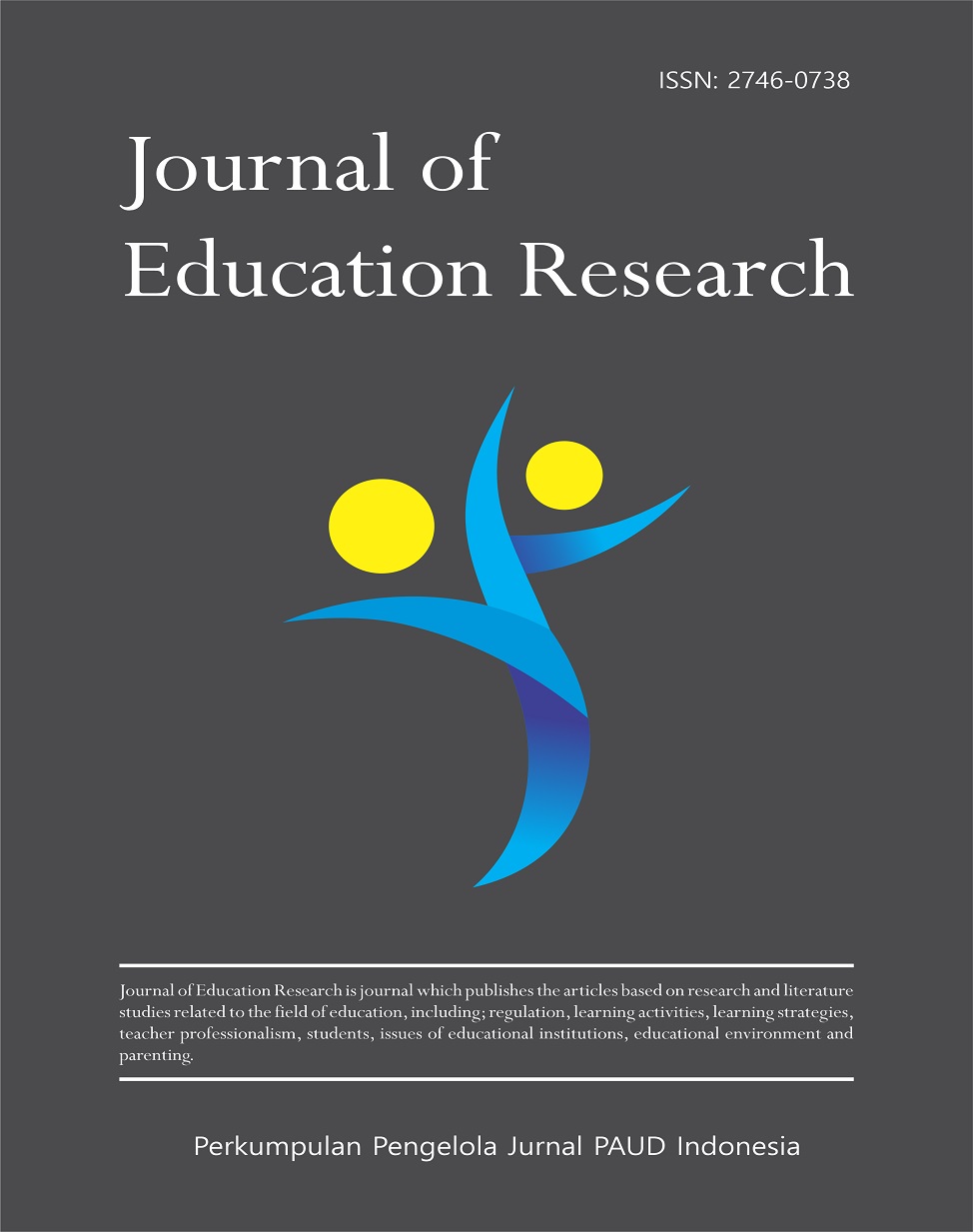Pengaruh Self Esteem, Self Regulation, dan Self Concept Terhadap Fomo pada Mahasiswa Bimbingan dan Konseling FKIP ULM
DOI:
https://doi.org/10.37985/jer.v6i3.2656Keywords:
Fear of missing out, Self-Esteem, Self-Regulation, Self-Concept, Model Persamaan strukturalAbstract
Fenomena Fear of Missing Out (FoMO) kian marak di kalangan mahasiswa seiring meningkatnya penggunaan media sosial. Penelitian ini bertujuan untuk menganalisis pengaruh self-esteem, self-regulation, dan self-concept terhadap FoMO pada mahasiswa Bimbingan dan Konseling FKIP ULM. Menggunakan pendekatan kuantitatif dengan metode Structural Equation Modeling (SEM) dan teknik sampling jenuh, sebanyak 270 mahasiswa dijadikan responden. Hasil penelitian menunjukkan bahwa ketiga variabel self-esteem, self-regulation, dan self-concept memiliki pengaruh positif dan signifikan terhadap FoMO. Temuan ini mengindikasikan bahwa individu dengan harga diri, regulasi diri, dan konsep diri yang tinggi justru dapat lebih rentan mengalami FoMO. Studi ini memberikan kontribusi dalam memahami dinamika psikologis mahasiswa dalam konteks media sosial, serta menjadi dasar bagi pengembangan strategi bimbingan dan konseling yang relevan.
Downloads
References
Brailovskaia, J., Ozimek, P., Rohmann, E., & Bierhoff, H.-W. (2023). Vulnerable narcissism, fear of missing out (FoMO) and addictive social media use: A gender comparison from Germany. Computers in Human Behavior, 144, 107725.
Calhoun, J. F., & Acocella, J. R. (1995). Psikologi tentang penyesuaian dan hubungan kemanusiaan. Semarang: IKIP Semarang.
Darussalam, B. G. E., Mahadewi, B. A. E., Wijiati, D. A., Dewi, D. F. A. K., Dewayani, E. N. A. H., & Ediyono, S. (2023). Hubungan Fear Of Missing Out (Fomo) Dengan Self-Regulation Pada Mahasiswa.
Deny, M., & Darwis, D. (2023). Hipertensi merupakan salah satu penyait paling umum di negara berkembang seperti indonesia, dimana tekana darah tinggi sistolik sekitar 140 mmHg dan tekana darah diastolik sekitar 90 mmHg di anggap tekanan darah orang tersebut tinggi dan beresiko mengalam. JIMPK: Jurnal Ilmiah Mahasiswa & Penelitian Keperawatan, 3(2).
Dewi, N. K., Hambali, I., & Wahyuni, F. (2022). Analisis intensitas penggunaan media sosial dan social environment terhadap perilaku FoMo. Jurnal Ilmu Keperawatan Jiwa, 5(1), 11–20.
Firmawati, Y., & Usman, N. (2017). Pengaruh Kepemimpinan Kepala Sekolah Dan Motivasi Kerja Terhadap Kinerja Guru. Jurnal Administrasi Pendidikan: Program Pascasarjana Unsyiah, 5(3).
Ghozali, I. (2017). Model persamaan struktural konsep dan aplikasi dengan program AMOS 24. Semarang: Badan Penerbit Universitas Diponegoro.
Ginting, D. B. (2009). Structural equation model (SEM). Media Informatika, 8(3), 121–134.
Hair, J. F., Gabriel, M., & Patel, V. (2014). AMOS covariance-based structural equation modeling (CB-SEM): Guidelines on its application as a marketing research tool. Brazilian Journal of Marketing, 13(2).
Hair, J. F., Risher, J. J., Sarstedt, M., & Ringle, C. M. (2019). When to use and how to report the results of PLS-SEM. European Business Review, 31(1), 2–24.
Kaloeti, D. V. S., Kurnia S, A., & Tahamata, V. M. (2021). Validation and psychometric properties of the Indonesian version of the Fear of Missing Out Scale in adolescents. Psicologia: Reflexao e Critica, 34, 15.
Khalid, K., Abdullah, H. H., & Kumar M, D. (2012). Get along with quantitative research process. International Journal of Research in Management, 2(2), 15–29.
Mashlihah, L. N., & Hasyim, M. (2019). Pengaruh self-esteem, self-regulation, dan self-confidence terhadap kemampuan pemecahan masalah matematika. JP2M (Jurnal Pendidikan Dan Pembelajaran Matematika), 5(2), 44–50.
Muhson, A. (2006). Teknik analisis kuantitatif. Universitas Negeri Yogyakarta. Yogyakarta, 183–196.
Przybylski, A. K., Murayama, K., DeHaan, C. R., & Gladwell, V. (2013). Motivational, emotional, and behavioral correlates of fear of missing out. Computers in Human Behavior, 29(4), 1841–1848.
Puti Aurira, Tri Rejeki Andayani, Mahardika Supratiwi, & Fajar Nursodiq. (2023). Fear of Missing Out Scale Adaptation in Indonesia. Psychological Research on Urban Society, 6(2). https://doi.org/10.7454/proust.v6i2.1127
Raskin, R., Novacek, J., & Hogan, R. (1991). Narcissistic self-esteem management. Journal of Personality and Social Psychology, 60(6), 911.
Rokhmatika, N. (2024). Pengembangan Instrumen Self-Esteem Coopersmith (Citra Diri). Jurnal Literasi Indonesia, 1(1), 1–8.
Servidio, R., Sinatra, M., Griffiths, M. D., & Monacis, L. (2021). Social comparison orientation and fear of missing out as mediators between self-concept clarity and problematic smartphone use. Addictive Behaviors, 122, 107014.
Setiawan, B. (2022). Pengembangan Self-Regulation Scale Mahasiswa berdasarkan Zimmerman Self-Regulation Model. Prophetic: Professional, Empathy, Islamic Counseling Journal, 5(2), 215–228.
Statistikian. (2024). Penjelasan SEM AMOS: Validitas Reliabilitas dan Path Analysis. https://www.statistikian.com/2024/06/penjelasan-sem-amos-validitas-path-analysis-part-3.html
Stead, H., & Bibby, P. A. (2017). Personality, fear of missing out and problematic internet use and their relationship to subjective well-being. Computers in Human Behavior, 76, 534–540.
Surya, D., & Aulina, D. (2020). Self-regulation as a predictor of Fear of Missing Out in emerging adulthood. INSPIRA: Indonesian Journal of Psychological Research, 1(1), 1–5.
Tandon, A., Dhir, A., Almugren, I., AlNemer, G. N., & Mäntymäki, M. (2021). Fear of missing out (FoMO) among social media users: a systematic literature review, synthesis and framework for future research. Internet Research, 31(3), 782–821. https://doi.org/10.1108/INTR-11-2019-0455
Urifan, M. F., & Pravesti, C. A. (2025). Hubungan Antara Self-Esteem dengan Fear of Missing Out (FoMO) Siswa SMA. G-Couns: Jurnal Bimbingan Dan Konseling, 9(2), 1236–1246.
Downloads
Published
How to Cite
License
Copyright (c) 2025 Muhamad Rico Ramadhan, Ali Rachman, Ririanti Rachmayanie Jamain

This work is licensed under a Creative Commons Attribution-ShareAlike 4.0 International License.
Authors who publish with this journal agree to the following terms:
- Authors retain copyright and grant the journal right of first publication with the work simultaneously licensed under a Creative Commons Attribution-ShareAlike 4.0 International License that allows others to share the work with an acknowledgement of the works authorship and initial publication in this journal.Â
- Authors are able to enter into separate, additional contractual arrangements for the non-exclusive distribution of the journals published version of the work (e.g., post it to an institutional repository or publish it in a book), with an acknowledgement of its initial publication in this journal.
- Authors are permitted and encouraged to post their work online (e.g., in institutional repositories or on their website) prior to and during the submission process, as it can lead to productive exchanges, as well as earlier and greater citation of published work (See The Effect of Open Access).









